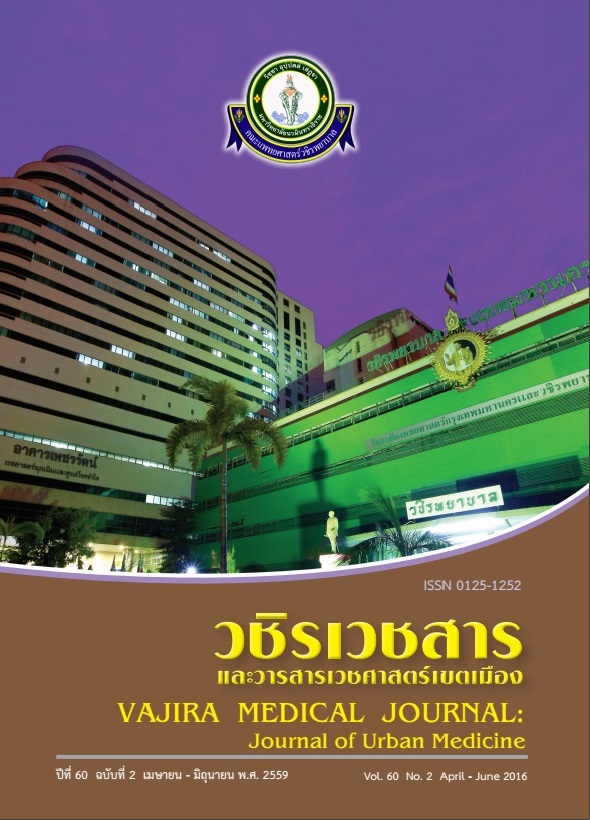A Comparative Study of 2.5% Acetic acid and Ofloxacin Ear Drop for Treatment of Acute Otitis Externa
Main Article Content
Abstract
Objective:To compare outcome of treatment of acute otitis externa between 2.5% acetic acid and ofloxacin ear drop
Methods:This study is a randomized controlled trial. In acetic acid group, 5% acetic acid from the market was diluted 1:1 with drinking water to 2.5% acetic acid. In ofloxacin ear drop group, 0.3% Tarivid® otic solution was used. Patients in both groups used same process of using antibiotic ear drop and were followed up for pain score, discharge in ear and ear canal swelling at 7, 14 and 21 days after treatment.
Results:108 patients received 2.5% acetic acid and 109 patients received ofloxacin ear drop. Mean age was 43.6 years. Female were more common than male. Cure rate at 7,14 and 21 days of ofloxacin ear drop group were 88.07%, 93.58% and 93.58% consecutively and those of acetic acid group were 89.94%, 94.47% and 95.40%, consecutively.There were no statistically significant difference of cure rate between groups. 79 patients (67.52%), comprised 14 patients (12.73%) from ofloxacin group and 65 patients (59.1%) from acetic acid group, had burning sensation in ear canal in the first 3 day of use. No patient had burning sensation after 7 days.
Conclusion:2.5% Acetic acid and ofloxacin ear drop had similar efficacy for treatment of acute otitis externa. But 2.5% Acetic acid caused more burning sensation in the first 3 days
Downloads
Article Details
References
2. Dibb WL. Microbial aetiology of otitis externa. J Infect. 1991;22:233-9.
3. Roland PS, Stroman DW. Microbiology of acute otitis externa. Laryngoscope. 2002;112(7):1166-77.
4. Agius AM, Pickles JM, Burch KL. A prospective study of otitis externa. Clin Otolaryngol. 1992;17:150-4.
5. Rosenfeld RM, Culpepper L, Doyle KJ, Grundfast KM, Hoberman A, Kenna MA, et al. Clinical practice guideline: Acute otitis externa. Otolaryngol Head Neck Surg. 2006 Apr;134(4 Suppl):S4-23.
6. Rosenfeld RM, Singer M, Wasserman JM, Stinnett SS. Systematic review of topical antimicrobial therapy for acute otitis externa. Otolaryngol Head Neck Surg. 2006;134(4 Suppl):S24-48.
7. Jones RN, Milazzo J, Seidlin M. Ofloxacin otic solution for treatment of otitis externa in children and adults. Arch Otolaryngol Head Neck Surg. 1997;123:1193-200.
8. Simpson KL, Markham A. Ofloxacin otic solution:a review of its use in the management of ear infections. Drugs. 1999 Sep;58(3):509-31.
9. Thorp MA, Kruger J, Oliver S, Nilssen EL, Prescott CA. The antibacterial activity of acetic acid and Burow’s solution as topical ontological preparations. J Laryngol Otol 1998;112(10):925-8.
10. Sloss JM, Cumberland N, Milner SM. Acetic acid used for the elimination of Pseudomonas aeruginosa from burn and soft tissue wounds. J R Army Med Corps. 1993;139(2):49-51
11. Philips I, Lobo AZ, Fernandes R, Gundara NS. Acetic acid in the treatment of superficial wounds infected by Pseudomonas aeruginosa. Lancet. 1968;1:11-4
12. Basavraj N, Bharat W, Prabhakar Ki, Shirish K. Acetic acid treatment of Pseudomonal wound infections. Eur J Gen Med. 2008;5(2):104-6.
13. Telma MS, Ana CC, Mariella VP, Antonio OC. Vinegar as an antimicrobial agent for control of Candida spp. in complete denture wearers. J Appl Oral Sci. 2008;16(6):385-90.
14. vanBalen FAM, Smit WM, Zuithoff NPA, Verheij TJ. Clinical efficacy of three common treatments in acute otitis externa in primary care: randomised controlled trial. BMJ. 2003; 327(7425):1201-5.
15. Torum B, Block SL, Avila H. Efficacy of ofloxacinotic solution once daily for 7 days in the treatment of otitis externa: a multicenter, open-label, phase III trial. Clin Ther. 2004;26(7):1046-54.
16. Dibb WL. Microbial aetiology of otitis externa. J Infect. 1991;22: 233-9.
17. Agius AM, Pickles JM, Burch KL. A prospective study of otitis externa. Clin Otolaryngol. 1992;17:150-4.
18. Cassisi N, Cohn A, Davidson T, Witten BR. Diffuse otitis externa: clinical and microbiologic findings in the
course of a multicenter study on a new otic solution. Ann Otol Rhinol Laryngol. 1997;86(Suppl39):1-16.
19. Clark WB, Brook I, Bianki D. Microbiology of otitis externa. Otolarngol Head Neck Surg. 1997;116:23–5.
20. Jones RN, Milazzo J, Seidlin M. Ofloxacinotic solution for treatment of otitis externa in children and adults. Arch Otolaryngol Head Neck Surg. 1997;123:1193-200.
21. Pistorius B, Westberry K, Drehobl Williams D, Bock TH, Lucente F, Prospective, randomized, comparative trial of ciprofloxacin otic drops, with or without hydrocortisone, vs polymyxin B-neomycin-hydrocortisone otic suspension in the treatment of acute diffuse otitis externa. Infect Dis Clin Pract. 1999;8:387–95.
22. Arshad M, Khan NU, Ali N. Sensitivity and spectrum of bacterial isolates in infectious otitis externa. J Coll Physicians Surg Pak. 2004;14:146-9.
23. Manolidis M, Freidman R, Hannley M. Comparative efficacy of aminoglycoside versus fluoroquinolone topical antibiotic drops. Otolaryngol Head Neck Surg. 2004;130(Suppl):S83-S88.


